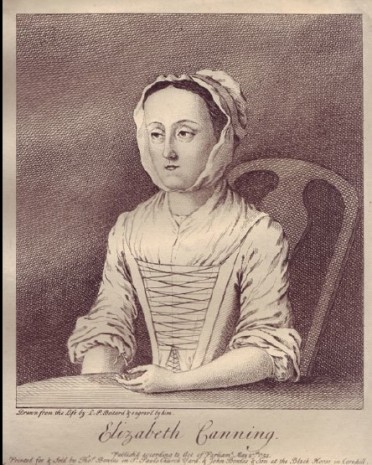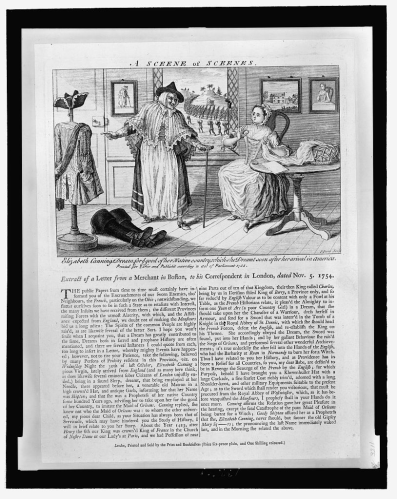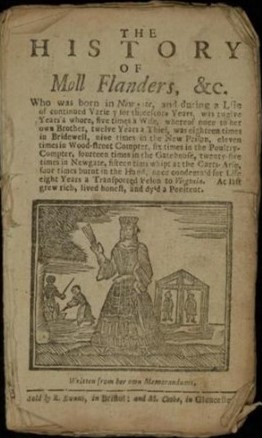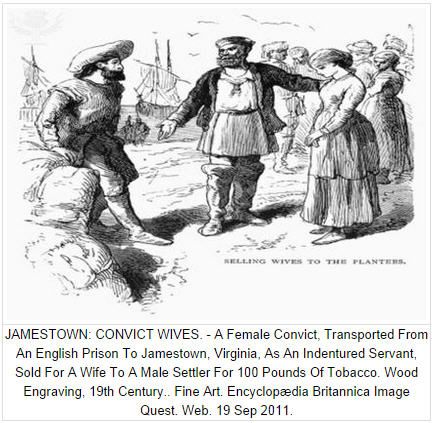 [1]
[1]
Elizabeth Canning by Louis Philippe Boitard, published by Thomas Bowles Jr, published by John Bowles line engraving, published 27 May 1754 NPG D19865.
Thousands of women convicts were transported to the American colonies between 1718 and 1775[2] but Elizabeth Canning’s story made her famous. In 1753, Elizabeth Canning working as a scullery maid, disappeared on New Year’s Day as she was walking home from her aunt and uncles and claimed that, ‘two lusty men, both in great coats, laid hold of me, one on each side’, and relieved her of her money, gown and hat and forced her to go to the house of a known prostitute, Susannah Wells. There she met a gypsy woman called Mary Squires, who suggested that she become a prostitute[3] , but having declined this, Elizabeth claimed that Mary Squires took a knife and having ‘put Elizabeth in fear of her life, stole one pair of stays of the value of ten shillings’. Elizabeth said she was held prisoner for four weeks but managed to escape by breaking a board that was nailed up at a window and ran home. [4] Both Squires and Wells were convicted of violent theft and Wells was sentenced to branding and six months in Newgate prison, whilst Mary Squires was sentenced to death. [5]
However, Mary Squires said that she had been elsewhere and had witnesses so her sentence was respited for 6 weeks[6].’ The Judge not entirely believing Elizabeth, ordered further enquiries. The defendants then produced witnesses who were willing to give testimony in ‘such clear, ample, convincing Circumstances, as would demand universal Assent; and fully prove, the Innocence of the three Defendants, and the Falsity of Elizabeth Canning ‘s Story in every particular’.[7]
Elizabeth was convicted of ‘wilful and corrupt perjury’, imprisoned in Newgate, and ordered to be transported for seven years[8] but her story had attracted many sympathisers who paid her passage to America where she was sent to live with a Minister and his family in Wethersfield Connecticut[9].

The vast majority of convict women were transported to the British colonies of Maryland and Virginia, after the Transportation Act of 1718[11] and 98% of women, unlike Elizabeth, were convicted of theft related crimes. Some types of theft carried the death penalty and women would often claim they were pregnant and would, ‘plead their belly’. A ‘Jury of the Matrons’, twelve women who had had experience of pregnancy and childbirth would examine the woman to confirm or deny and if the claim was accepted the woman could be pardoned or transported, otherwise the original sentence would be carried out[12] e.g. 1684 Ann Parker[13], a notorious thief, was found guilty for the third time but pleaded her belly and was found to be, ‘quick with child’ and her death sentence was respited. Often the value of the goods taken would be ‘downvalued’ so that grand larceny became petty theft and execution could be transmuted to transportation e.g. in 1718 Margaret Hawkins stole apparel valued 22s but it was downgraded to under 1s and she was transported instead.[14]. Some were children, e.g. Mary Johnson, aged 10, lived with her mother in 1730 in the cellar of the Prosecutor’s house and having stolen property to the value of 10d, was found guilty and sentenced to transportation.[15] Only after 1691, could women claim benefit of clergy like men.
 [16]
[16]
Probably the most famous woman transported to the British American colonies is the fictional character in the novel by Daniel Defoe in 1760, Moll Flanders. Moll, born in Newgate prison was born to a woman transported to the colonies and survived as a prostitute and thief. After being caught and whipped several times she is sentenced to death and like Canning, she is transported to the colonies. There she finds her mother has left her a farm, and now having money and returns to England.[17]
Fewer women than men ran away but some managed to return to England before their sentence was up which meant they faced the death penalty eg. Mary Brown[18], a known shoplifter, who was transported the year before but had returned and stolen goods again, was sentenced to death but it was respited for pregnancy. Moll Flanders returned to England with money and lived out her life in comfort and others like Canning stayed and made lives in the colonies.
 [19]
[19]
[1] Elizabeth Canning by Louis Philippe Boitard, published by Thomas Bowles Jr, published by John Bowles line engraving, published 27 May 1754 NPG D19865. National Portrait Gallery. Accessed at: https://www.npg.org.uk/collections/search/person/mp69173/elizabeth-canning on 2/12/2018.
[2] Old Bailey Statistics show 4003 from this court alone. Accessed at:https://www.oldbaileyonline.org/forms/formStats.jsp on 2/12/2018.
[3] Mary Squires, Susannah Wells. Violent Theft: robbery, Violent Theft: robbery. 21st February 1753. Accessed at: https://www.oldbaileyonline.org/browse.jsp?div=t17530221-47 on 3/12/2018.
[4] Mary Squires, Susannah Wells. Violent Theft: robbery, Violent Theft: robbery. 21st February 1753. Accessed at: https://www.oldbaileyonline.org/browse.jsp?id=t17530221-47-victim401&div=t17530221-47#highlight on 3/12/2018.
[5] Old Bailey Proceedings punishment summary. 21st February 1753. Accessed at: https://www.oldbaileyonline.org/browse.jsp?div=s17530221-1 on 4/12/2018.
[6] Mary Squires, Susannah Wells. Violent Theft: robbery, Violent Theft: robbery. 21st February 1753.Accessed at:https://www.oldbaileyonline.org/browse.jsp?id=OA17530416n15-3&div=OA17530416#highlight on 4/12/2018.
[7] John Gibbon, William Clarke, Thomas Greville, John Gibbon, William Clark, Thomas Greville. Deception: perjury, Deception: perjury, Deception: perjury. 6th September 1753. Accessed at : https://www.oldbaileyonline.org/browse.jsp?id=t17530906-45-person325&div=t17530906-45#highlight on 4/12/2018.
[8] Old Bailey Proceedings supplementary material. Elizabeth Canning. 30th May 1754 Accessed at : https://www.oldbaileyonline.org/browse.jsp?id=o17540530-1-punish200&div=o17540530-1#highlight on 4/12/2018.
[9] New England Historical Society. Accessed at: http://www.newenglandhistoricalsociety.com/elizabeth-canning-leaves-scandal-behind-connecticut/ on 4/12/2018.
[10] Canning, Elizabeth,–1734-1773. [England] : Printed for T. For and publish’d according to Act of Parliament, 1755. A sceene of sceenes. Elizabeth Cannings dream for ye good of her native country, which she dreamt soon after her arrival in America / J. June, sculpLibrary of Congress id number 2006676853. Accessed at: https://www.loc.gov/item/2006676853/ on 26/11/2018.
[11] Scott Craig. Women, Crime and the Experience of Servitude in Colonial America and Australia. Limina, Volume 19, 2013 Pg 3
[12] Naomi Clifford, Love, Life and death in the Georgian era. Pregnant and condemned: Pleading the belly and the jury of matrons. Accessed at: https://www.naomiclifford.com/pleading-the-belly-jury-of-matrons/ on 5/11/18.
[13] Ann Parker.1684. https://www.oldbaileyonline.org/browse.jsp?id=t16841008-2-off5&div=t16841008-2#highlight
[14] Margaret Hawkins. 1718. Accessed at : https://www.oldbaileyonline.org/browse.jsp?id=t17180423-35-off186&div=t17180423-35#highlight
[15] Mary Johnson. Theft: grand larceny. 4th December 1730. t17301204-54 Accessed at https://www.oldbaileyonline.org/browse.jsp?id=t17301204-54-off283&div=t17301204-54#highlight . on 4/11/18.
[16] Daniel Defoe. Ca.1760. The History of Moll Flanders, &c., PR3404 .M625 1760, Special Collections, University of Virginia, Charlottesville, Va.
[17] Daniel Defoe. Moll Flanders. (London, William Rufus Chetford, 1722)
[18] Mary Brown. Theft-Shoplifting 1737. Accessed at: https://www.oldbaileyonline.org/browse.jsp?id=t17370420-44-off238&div=t17370420-44#highlight on 06/12/2018.
[19] James Town Convict Wives. Wood Engraving 19th Century. Encyclopaedia Britannia Image Quest. 2011.